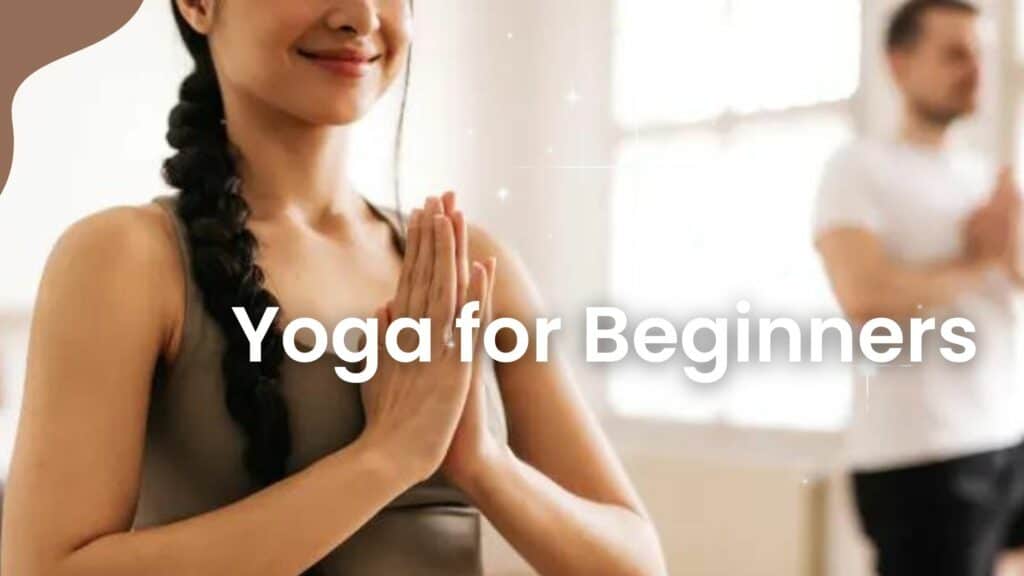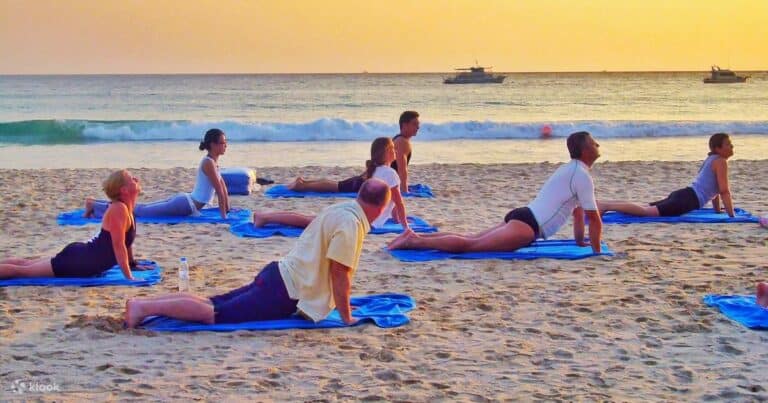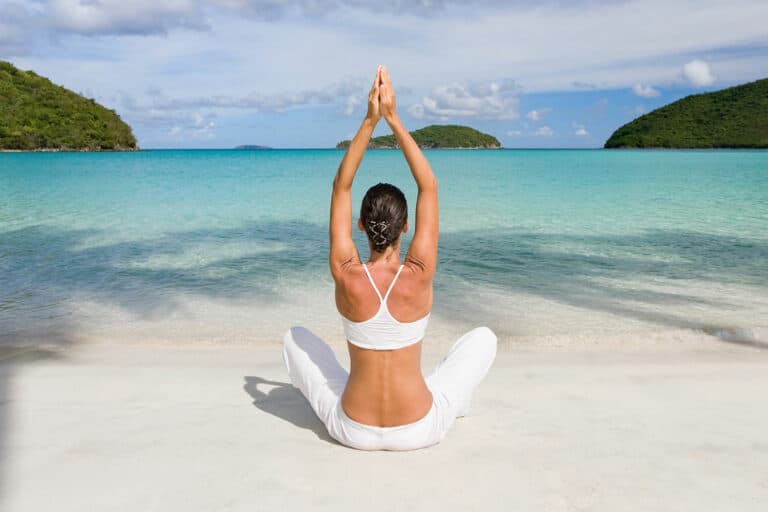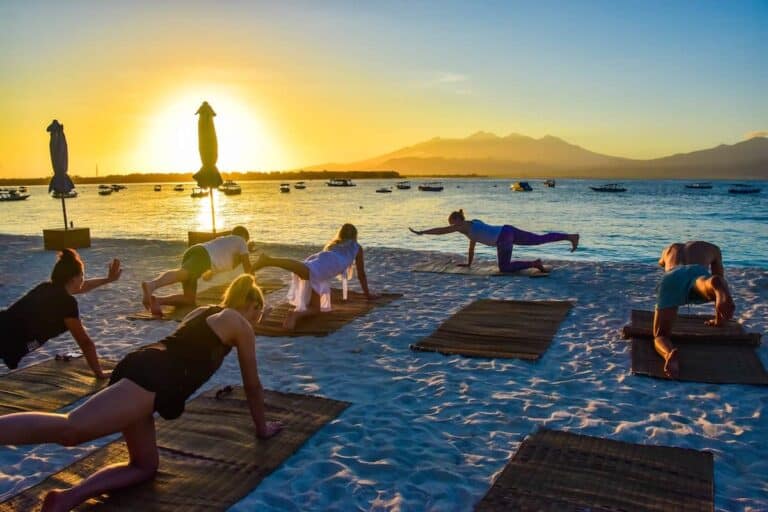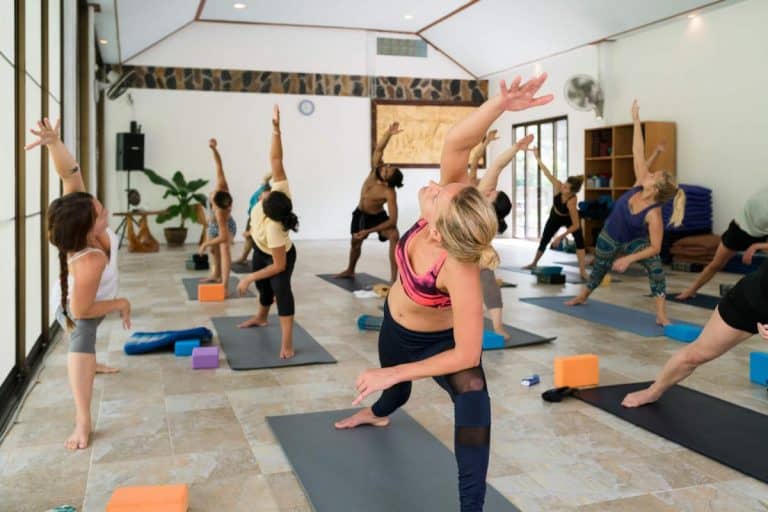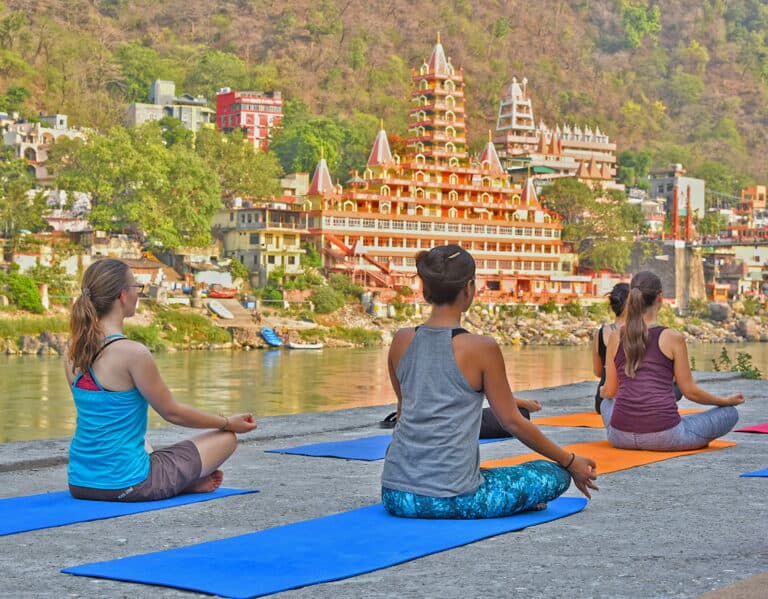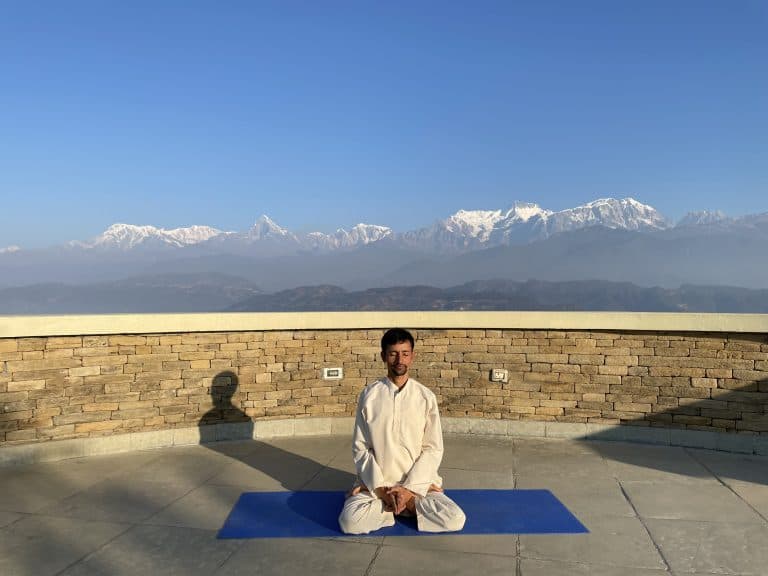If you’re looking to improve your well-being, there’s no better way to do it than through yoga. Though it may seem daunting at first, we promise you’ll be hooked once you get started!
To help ease you into the world of yoga, we’ve put together a beginner’s guide complete with all the different types of yoga and their benefits, as well as some tips on how to get started.
Trust us – after reading this guide, you’ll be ready to jump headfirst into your new wellness journey!
What is Yoga?
Yoga is an ancient practice that started in India thousands of years ago, which helps bring together your body, mind, and spirit. The word “yoga” comes from the Sanskrit language and means to unite or join. Yoga is all about improving your well-being by focusing on self-awareness, inner peace, and personal growth.
The main parts of yoga are physical poses (called asanas), breathing exercises (called pranayama), and meditation. These elements work together to help you become stronger, more flexible, and balanced while also helping you relax and think clearly. There are many different types of yoga, like Hatha, Vinyasa, Ashtanga, Kundalini, and Yin Yoga, so you can find the one that suits you best.
Yoga has lots of benefits for your body and mind, such as making your muscles stronger, helping you stretch, reducing stress, improving concentration, and helping you sleep better. Anyone can do yoga, no matter their age, fitness level, or experience, because there are ways to make the poses easier or harder, depending on what works for you.
Common Types of Yoga
From the more gentle Hatha yoga to the faster-paced Ashtanga yoga, there is something for everyone. Different types of yoga also offer different health benefits, so choosing a style that suits your needs is important.
We’ve outlined a few common styles below:
Hatha Yoga
Hatha yoga is one of the most popular types of yoga in the Western world and is a good place to start if you are new to yoga.
Hatha means ‘forceful’ or ‘willful’ in Sanskrit, and this type of yoga focuses on physically challenging poses as a way to calm the mind.
Classes typically move at a slower pace than some other styles of yoga so that you can hold each pose for longer and really feel the stretch.
Ashtanga Yoga
Ashtanga Yoga is a dynamic and rigorous style of yoga that combines breath, movement, and a specific sequence of postures to create a flowing and energizing practice. It was developed by Sri K. Pattabhi Jois in the 20th century and is rooted in the ancient Yoga Sutras of Patanjali. The word “Ashtanga” translates to “eight limbs,” referring to the eightfold path outlined by Patanjali that guides practitioners toward self-realization and spiritual growth.
Ashtanga Yoga follows a set series of postures linked together using a method called “vinyasa” – a synchronized breath and movement system. There are six progressive series in Ashtanga Yoga, with each series becoming increasingly more challenging. Most practitioners begin with the Primary Series, which focuses on detoxifying the body, aligning the spine, and building strength and flexibility.
The practice is characterized by its emphasis on breath (ujjayi breathing), internal energy locks (bandhas), and focused gaze points (dristi), which work together to create a meditative and transformative experience. Ashtanga Yoga is typically practiced in a Mysore-style class, where students work independently on their own sequence at their own pace, under the guidance of a knowledgeable teacher.
Yin Yoga
Yin Yoga is a gentle and introspective style of yoga that focuses on deepening flexibility, releasing tension, and cultivating mindfulness. It is inspired by traditional Chinese medicine and Taoist principles and aims to balance the flow of energy or “chi” within the body. Unlike more dynamic styles like Vinyasa or Ashtanga, the Yin style involves holding passive poses for longer periods, typically between 3 to 5 minutes or longer.
The practice targets the deeper connective tissues in the body, such as fascia, ligaments, and joints, rather than focusing primarily on the muscles. By holding poses for extended periods, practitioners gently stretch these tissues, increasing flexibility and promoting the health of the joints. This slow and meditative practice also provides an opportunity to cultivate mental stillness as you turn your attention inward and become more aware of your breath, thoughts, and emotions.
This style is suitable for beginners as well as experienced yogis and can be an excellent complement to more dynamic or yang-style practices. It is particularly beneficial for individuals seeking relaxation, stress relief, and improved flexibility.
Bikram Yoga
Bikram Yoga, also known as hot yoga, is a distinct style of yoga founded by Bikram Choudhury in the early 1970s. It consists of a series of 26 postures (asanas) and two breathing exercises, performed in a specific sequence within a heated room, usually set to 105°F (40.6°C) with 40% humidity. The heat and humidity are designed to warm your muscles, promote flexibility, and encourage detoxification through sweating.
Each Bikram Yoga class runs for 90 minutes, and the postures are performed twice, with each posture targeting a specific area of the body. This practice is known for its focus on strength, balance, and flexibility while providing a cardiovascular workout. The consistency of the sequence allows practitioners to track their progress and develop a deeper understanding of their bodies over time.
Due to the heat and strict structure, Bikram Yoga can be intense and challenging, especially for beginners. However, with proper hydration, listening to your body, and practicing consistently, many individuals experience physical and mental benefits, such as improved flexibility, increased strength, stress relief, and weight loss. It is essential to consult with a healthcare professional before starting Bikram Yoga, especially if you have any pre-existing medical conditions or concerns.
Kundalini Yoga
Kundalini Yoga, sometimes called the “Yoga of Awareness,” is a unique and beginner-friendly style that combines physical poses, breathing exercises, meditation, and chanting to awaken powerful energy within you. This energy, known as Kundalini, is like a coiled serpent resting at the base of your spine, representing your untapped creative and spiritual potential.
This style of yoga aims to uncoil this energy and let it flow through your seven energy centers or chakras to help you achieve heightened awareness, self-discovery, and inner peace.
Introduced to the Western world by Yogi Bhajan in the late 1960s, Kundalini Yoga focuses on the holistic development of your body, mind, and spirit. It’s an excellent practice for beginners seeking a more spiritual and reflective yoga experience with the potential to transform their life in profound ways.
Vinyasa Yoga
Vinyasa, often referred to as “flow yoga,” is a dynamic and popular style of yoga that focuses on seamlessly linking breath with movement. The term “vinyasa” can be translated as “to place in a special way,” which reflects the intentionality of connecting each posture with mindful transitions. This practice originated from the Ashtanga tradition and has since evolved into various forms, offering creative sequences and diverse class structures.
In Vinyasa Yoga, each movement is synchronized with the breath, typically inhaling to expand or lift and exhaling to contract or lower. The continuous flow of postures and breath creates a rhythmic, meditative experience, helping to build strength, flexibility, and mental focus. Vinyasa classes are often characterized by their variety, as each teacher may create their own unique sequence, drawing from a wide range of asanas.
Suitable for beginners as well as experienced practitioners, the Vinyasa style of yoga offers a range of modifications and variations to accommodate different skill levels and personal preferences. The fluidity of the practice allows individuals to explore their edge, deepen their connection to the breath, and cultivate mindfulness in motion. As with any yoga practice, listening to your body and progressing at your own pace is essential, ensuring a safe and enjoyable experience.
It can be overwhelming, at first, to know where to start. Just try a few different styles and see which ones resonate with you. There’s no rush, and no one-size-fits-all path is right for everyone.
The Health Benefits of Yoga
If you’re like most people, you probably think of yoga as a good workout for your mind and body. Yoga can improve your flexibility, balance, and muscle strength.
It also helps with conditions such as anxiety, depression, fatigue, pain management, and blood pressure control. But you may not know that yoga can also boost your immune system, increase energy levels and improve cardiovascular health.
In fact, there are endless benefits to practicing yoga regularly.
Here’s a closer look at some of the key ways yoga can benefit your health:
Yoga Can Improve Your Flexibility.
One of the most obvious benefits of yoga for beginners is increased flexibility.
When you stretch and tone muscles through different poses, you’ll eventually be able to move your body in new ways and achieve positions you never thought possible.
This increased range of motion helps reduce joint stiffness and increase the overall mobility of tight muscles.
Improved Balance & Coordination.
Another great perk associated with improved flexibility is better balance and coordination.
As we age, it’s common to lose our sense of balance – but regular sessions on the mat can help maintain this important function well into old age!
The more flexible you become, the easier it will be to keep your footing during everyday activities like walking or standing up from a chair.
Yoga Can Enhance Your Mood & Relieve Stress.
We all know how good it feels to finally take a break from work and relax on the couch with a glass of wine after a long day.
But what if we told you there was an activity that could provide the same sense of relaxation without the need for alcohol or Netflix?
That’s where yoga therapy comes in! Studies have shown that regular yoga practice can help alleviate stress, anxiety, and depression.
In fact, one study even found that just eight weeks of practicing yoga helped participants reduce their levels of cortisol – the stress hormone – by nearly 30 percent!
Yoga Can Boost Your Energy Levels.
If you’re someone who always feels exhausted, even after a full night’s sleep, yoga may be able to help. One study found that just eight weeks of practicing yoga helped participants increase their energy levels by nearly 20 percent!
Another study found that regular yoga practice can help improve fatigue and quality of life in cancer patients undergoing chemotherapy. So if you’re looking for a natural way to boost your energy levels, add some Downward Dogs to your daily routine.
Yoga Is Good For Your Heart.
Heart disease is a leading cause of death in the United States. Regular yoga practice can help reduce the risk of developing heart disease by lowering blood pressure and slowing heart rate. Yoga also reduces stress and anxiety, which contribute to high blood pressure.
Yoga supports overall cardiovascular health by improving circulation and lung function and promoting a healthy lifestyle. Incorporating yoga into a well-rounded fitness routine can proactively maintain a healthy heart.
Common Mistakes Made by Beginner Yogis
We all know that yoga is a great way to improve our overall well-being, but as beginners, it’s easy to make mistakes. Here are some common ones to avoid!
Not Doing Your Research.
Before jumping into your first yoga class, it’s important to research and find the right class for you. There are many different types of yoga with varying levels of difficulty, so it’s important to choose one that suits your abilities and interests.
Trying a challenging class when you’re not ready can be frustrating and overwhelming, so take the time to find the perfect fit before heading to the mat.
Wearing the Wrong Clothing.
When selecting an outfit for yoga, comfort should be key. You want something that won’t restrict your movement or cause discomfort while flowing through each pose.
Avoid anything too loose or baggy, as this can get in the way, and steer clear of clothes made from thick materials like denim – they’ll only make you hot and sweaty (trust us).
Instead, opt for light layers of breathable fabrics such as cotton or bamboo.
Being Afraid to Ask Questions
Feeling hesitant about asking questions during your yoga class is a common concern, but don’t let that hold you back. If you’re uncertain about a pose or technique, don’t be afraid to seek clarification from your instructor.
Remember, there are no stupid questions, and instructors are there to help and guide you on your yoga journey.
By asking questions, you enhance your understanding and practice and contribute to a supportive and inclusive learning environment for everyone.
Forgetting the Water Breaks
Staying hydrated during your yoga class is important, especially when doing physical activity. Make sure to bring along a water bottle so that you can stay refreshed throughout your session. Don’t forget to drink water regularly; you will likely sweat more than you realize.
Skipping the Warm-Up.
Warming up beforehand is one of the most essential parts of any workout, yet many people skip this step when doing yoga. Warming up helps increase blood flow throughout the body, loosens stiff muscles, prepares joints for activity, and reduces injury risk.
So before jumping into things headfirst (literally), take some time to warm up with some basic stretches.
Going to Yoga Class on a Full Stomach.
Eating a big meal before exercise isn’t generally advised, regardless of your workout type. But since Yoga involves twisting, bending, and inverting the body in various ways, it’s especially important not to have food sitting in your stomach during class.
Try eating at least 2-3 hours beforehand or sticking with lighter options like fruit smoothies or yogurt if you need something closer to the start of class.
Holding Your Breath While You Exercise
It may sound counterintuitive, but proper breathing is actually quite important when working out– including during yoga flows.
Having trouble remembering to breathe?
Just focus on taking deep inhales whenever you transition into a new pose and exhaling completely as you exit it. If deep breathing sounds difficult at first, don’t worry. With time (and practice), it will become second nature.
Essential Yoga Gear for Beginners
When starting out as a beginner, knowing what gear is necessary to practice yoga effectively can be overwhelming. Make the most of your yoga class by making sure you have the right gear.
Yoga Mat
It goes without saying that a yoga mat is one of the most important items for practicing yoga. A yoga mat provides a stable and non-slip surface to practice on, which is essential for maintaining proper form and preventing injuries. Consider the thickness, material, and texture when choosing a yoga mat. Choosing a mat that is at least 1/4 inch thick and made of a non-slip material such as PVC or rubber is recommended. A textured surface can also provide additional grip and prevent slipping.
Comfortable Clothing
Yoga requires a lot of movement and flexibility, so it’s important to wear comfortable and breathable clothing that allows for a full range of motion. Look for clothing made of moisture-wicking materials that will keep you cool and dry throughout your practice. Also, choose clothing that is not too loose or too tight, as this can interfere with your movements.
Water Bottle
Staying hydrated is important during any form of exercise, and yoga is no exception. Make sure to bring a water bottle to your yoga practice and drink water throughout your session.
Yoga Blocks
Using a Yoga block is great for beginners as it can help assist with balance and provide support during poses. They can also be used to deepen stretches and provide additional support for the back, hips, and legs. When choosing yoga blocks, consider the size and material. Foam blocks are lightweight and easy to use, while cork blocks are more durable and offer more support.
Yoga Strap
A yoga strap is another useful tool for beginners, as it can help with flexibility and stretching. It can be used to extend your reach and deepen stretches and provide additional support for the back and legs. When choosing a yoga strap, consider the length and material. A strap that is at least 6 feet long and made of cotton or nylon is recommended.
Towel
A towel can be useful during yoga practice to wipe away sweat and provide additional grip on a slippery mat. Look for a towel made of absorbent and non-slip material that can be easily washed and dried.
Meditation Cushion
While not essential, a meditation cushion can provide additional support and comfort during seated poses and meditation. It can also help to elevate the hips and spine to maintain proper alignment. When choosing a meditation cushion, consider the size and material. A cushion that is at least 5 inches high and made of a supportive material such as buckwheat husks is recommended.
FAQs in Relation to Beginners Yoga
Can I teach myself yoga?
Yes, you can teach yourself yoga. However, it is important to note that there are different types of yoga, and some may be more difficult than others to learn on your own.
Additionally, while learning the basics of poses and breathing techniques may be possible without a teacher, developing a deeper understanding of the practice takes time and commitment.
For these reasons, attending classes with a qualified instructor – at least occasionally – is generally recommended for those interested in pursuing yoga seriously.
How many times a week should a beginner do yoga?
There is no definitive answer to this question. Depending on the individual, some people may benefit from practicing yoga once a week, while others may need to practice yoga multiple times per week.
Some beginners may find that they feel better after attending a regular weekly class, while others might prefer to do shorter yoga practices at home more frequently.
Ultimately it is up to the individual to experiment and see what works best for them in terms of frequency and duration of practice.
Is 30 minutes of yoga a day enough exercise?
Some people may find that 30 minutes of yoga a day is enough exercise, while others may need more or less depending on their fitness goals and level of activity. There is no one-size-fits-all answer to this.
Conclusion
Though it may seem daunting at first, with our beginner’s guide to yoga, you’ll be an expert in no time.
There are many different types of yoga, each with its own health benefits. To get started, all you need is some comfortable clothing and a mat.
Be sure to avoid common mistakes such as forcing yourself into uncomfortable positions or comparing yourself to others. Instead, focus on your breath and finding your flow.
Namaste!
